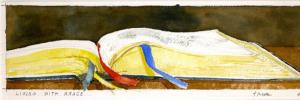Luxury Publishing
The idea of "luxury publishing" is by no means a
new concept, the tradition of artisans being commissioned by wealthy patrons to
create exquisite books that are coveted as works of art in and of
themselves--and which oftentimes contain text as secondary to the
artifact itself--has been with us for centuries. I am by no means opposed to
this convention--indeed, I have written admiringly on occasion about people who
make these books as well as those who covet, sell and collect them--but I have
always been fairly straightforward in my belief that the fundamental purpose of
a book is to inspire, instruct, and entertain, and that this, typically, is
done through the medium of the written word.
I was reminded of this by the announcement a few days ago that a book newly made at a cost of 100,000 euros--$127,120 at current conversion rates--had been given to the New York Public Library, which promptly put the sixty-two-pound volume on view in an impromptu exhibition expected to last for about a week. Called Michelangelo: La Dotta Mano ("Michelangelo: The Learned Hand"), the book was crafted in Italy over several months as a 264-page celebration of the great Renaissance master's work, and is adorned with a bas-relief depiction of "Madonna of the Steps" sculptured on a piece of white marble from one of the quarries in Carrara, Italy, that supplied stone for his statues. The NYPL copy was a gift from the publisher.
According to an article in the New York Times, the book's "positively sybaritic binding is swathed in red velvet from the same Italian workshop that supplied stage curtains to the Metropolitan Opera and La Scala in Milan. And the book's photographs and plates of drawings and images of the Sistine Chapel are printed on luxurious paper of pure cotton produced in Italy." The book is one of thirty-three made thus far by an Italian company called Gruppo FMR, twenty of which have been sold; ninety-nine altogether are planned.
I find especially interesting the assertion each book comes with a 500-year warranty. Lost in all this, though, is any real discussion of what's inside, other than some wonderful black-and-white photographs by the noted museum photographer Aurelio Amendola. What the NYPL put on display behind glass was simply the marble exterior. Unlike the Book of Kells in Dublin--where the pages are turned once a day--this volume remains closed, though the Times did put up a slide show of a few pages as a kind of teaser. For a complete view, I guess we'll all have to wait for the facsimile edition, which is sure to come along before long--and at a much more affordable price.
I was reminded of this by the announcement a few days ago that a book newly made at a cost of 100,000 euros--$127,120 at current conversion rates--had been given to the New York Public Library, which promptly put the sixty-two-pound volume on view in an impromptu exhibition expected to last for about a week. Called Michelangelo: La Dotta Mano ("Michelangelo: The Learned Hand"), the book was crafted in Italy over several months as a 264-page celebration of the great Renaissance master's work, and is adorned with a bas-relief depiction of "Madonna of the Steps" sculptured on a piece of white marble from one of the quarries in Carrara, Italy, that supplied stone for his statues. The NYPL copy was a gift from the publisher.
According to an article in the New York Times, the book's "positively sybaritic binding is swathed in red velvet from the same Italian workshop that supplied stage curtains to the Metropolitan Opera and La Scala in Milan. And the book's photographs and plates of drawings and images of the Sistine Chapel are printed on luxurious paper of pure cotton produced in Italy." The book is one of thirty-three made thus far by an Italian company called Gruppo FMR, twenty of which have been sold; ninety-nine altogether are planned.
I find especially interesting the assertion each book comes with a 500-year warranty. Lost in all this, though, is any real discussion of what's inside, other than some wonderful black-and-white photographs by the noted museum photographer Aurelio Amendola. What the NYPL put on display behind glass was simply the marble exterior. Unlike the Book of Kells in Dublin--where the pages are turned once a day--this volume remains closed, though the Times did put up a slide show of a few pages as a kind of teaser. For a complete view, I guess we'll all have to wait for the facsimile edition, which is sure to come along before long--and at a much more affordable price.
















